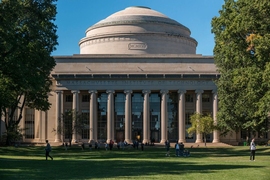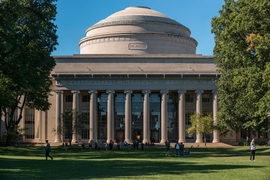It’s hard to name a field that artificial intelligence hasn’t impacted already. From mobile devices with facial recognition to self-driving cars, we are still experiencing waves of innovative technology that can be traced back to major breakthroughs in our understanding of intelligence, like machine learning. But the truth is, many of these breakthroughs driving current machine intelligence technology are actually decades old. So what’s next for the future of intelligence?
Building on a rich history of innovation and impact in the field of intelligence, MIT launched The Quest for Intelligence (The Quest) last spring. Comprised of two linked entities, The Core and The Bridge, The Quest aims to advance two fundamental intelligence challenges: Can we reverse engineer intelligence? And, how can we deploy our current and expanding understanding of intelligence to the benefit of society? Antonio Torralba, the inaugural director of The Quest, recently spoke on what he and his colleagues have been working on since the launch last spring. He describes how The Quest Core and The Quest Bridge will work together to advance our understanding of intelligence, and shares how others can join The Quest.
Q: What has The Quest been up to since it launched last spring?
A: It’s been a busy summer for The Quest! I’m proud of the leadership team we’ve assemble, and we've been working together to formalize our vision for the future of our efforts to support intelligence research and translation at MIT. We’ve also spent quite a bit of time doing outreach around campus to get a better sense of our own community’s interests and needs. We’ve discovered that there are so many people — across all five schools — who are interested in the topic of intelligence and how it can improve their respective field. It’s been exciting to create those connections with research groups you haven’t interacted with before.
Industry is extremely interested in intelligence because of the recent boom in machine learning, and there are boundless opportunities to collaborate with them as they pursue their own research in this space. Research collaborations with industry are beneficial for us because, for example, industry has access to interesting sources of data and high levels of computation that are harder to replicate at a university level. Industry can benefit from collaborating with an academic institution like MIT because they leverage our research to greatly improve their products and technology, as well as increased access to our amazing pool of students, which can inform the future workforce and help our graduates find jobs. It’s a mutually beneficial relationship for all involved.
IBM was our first big industry collaboration under the auspices of The Quest, and I am proud to serve as the director of the MIT-IBM Watson AI Lab. The goal of our collaboration with IBM is to advance AI hardware, software, and algorithms related to deep learning and other areas; increase AI’s impact on industries, such as health care and cybersecurity; and explore the economic and ethical implications of AI on society. The MIT-IBM Watson AI Lab is supporting research of more than 60 principal investigators from the five schools at MIT, working in collaboration with IBM researchers.
This summer, we announced an exciting new alliance with SenseTime to fund 27 projects involving about 50 principal investigators from departments and labs within engineering, science, architecture and planning, management, and the humanities and social sciences. The diversity of these projects under the MIT-SenseTime Alliance on Artificial Intelligence is a testament to what The Quest is all about: many interdisciplinary collaborations across multiple schools at MIT leveraging different skills and expertise towards a common goal — understanding intelligence and using that to create a better world.
Q: Can you tell us about the structure of The Quest? How will The Quest Core and The Quest Bridge support intelligence research and innovation at MIT?
A: The two linked entities that form The Quest address intelligence innovation in different phases of its development, and the diversity of approaches will lead to a more holistic understanding of intelligence itself and the impact it has on society.
The Quest Core will focus on fundamental research of human and machine intelligence through an intersection of science and engineering to fuel discovery. The heart of this effort are team-driven bets on large, unsolved problems in intelligence, which we are calling “moonshot” research projects. Moonshot projects go above and beyond business as usual — they strive to answer some of the most complex and enduring questions about intelligence. For example, Professor Josh Tenenbaum, one of the Scientific Directors of The Quest Core, is collaborating on a moonshot to build a machine that grows into intelligence like a human being does — that starts like a baby and learns like a child. Moonshots represent the best of foundational science research because they will have the freedom to pursue a longer-term goal with the flexibility to explore the unforeseen yet exciting insights and discoveries made along the way.
The Quest Bridge will connect discoveries and insights made under The Core to many other disciplines, from education, research, business and beyond, through mission projects, which will identify areas that could benefit from more intelligent systems and work to develop and deploy these systems ethically and transparently. A shining example of this approach is led by Associate Professor Cynthia Breazeal, associate director of strategic initiatives for The Quest Bridge, and her mission to leverage our understanding of human social and emotional intelligence to build robots that can perform more compassionate tasks, like helping children learn or engaging with people who suffer from depression.
To support the development of the different missions, The Bridge engineers have started building a platform of tools and services built around both research results from campus and computing resources from industry. In addition to this platform, The Bridge will offer expertise and help in using these tools and services as well as dedicated software engineering support on-campus to create new tools as needed. Our hope is that this platform of tools and services will accelerate the progress of all the research labs on campus and enrich the educational experience of every student here.
While both moonshots and missions address grand challenges, missions differ from moonshots in that once the technology is in place, The Bridge researchers will work on a much shorter timeline to solve real-world problems in the near-term. What is unique about The Quest is how, through our moonshots and missions, these interlocking entities place equal weight on the impact of intelligence on science and society, creating a more holistic approach to understanding intelligence and integrating it into society.
Q: What’s next for The Quest? How can the MIT community get involved?
A: We are just getting started, so everything is next, which is very exciting! A key component of our effort will build on the momentum of the unique culture of collaboration inherent to the MIT community. There are more than 200 faculty members at MIT who are interested in the problem of intelligence, directly or indirectly. To address the science and engineering challenges as well as the societal and ethical impacts of intelligence, it is crucial to engage with all five schools across MIT to ensure the success of our effort.
On that note, we are hosting the first of what we hope will be many events this year, “The Quest Brainstorm Workshop,” on Monday, Sept. 24 from 3-5 p.m. in Singleton Auditorium (Room 46-3002). After a brief overview of what The Quest is all about, we will open the floor for audience participation to discuss ideas for projects and collaborations, followed by a reception with refreshments provided.
Additionally, we will discuss additional opportunities for undergraduates to get involved with The Quest. Starting this fall, thanks to the generosity of former Alphabet executive chairman Eric Schmidt and his wife, Wendy; the MIT-IBM Watson AI Lab; and the MIT-SenseTime Alliance on Artificial Intelligence, The Quest will fund up to 100 undergraduate researchers through MIT’s Undergraduate Research Opportunities Program (UROP.)
Following the Quest Brainstorm Workshop, members of the MIT community in any of the five schools will be invited to submit white papers outlining ideas for novel projects. Projects that focus on human-intelligence-inspired approaches, accelerating research or improving education are highly encouraged, but projects of all kinds, including those centered around ethics, policies or social issues, are welcome. Our goal with this call for white papers is to identify, support and grow exciting ideas into concrete moonshots and missions that will form the foundation of The Quest.
No matter what your role is on campus — student, postdoctoral fellow, research scientist, faculty member and beyond — we hope that you will learn more about The Quest and how you can get involved.










